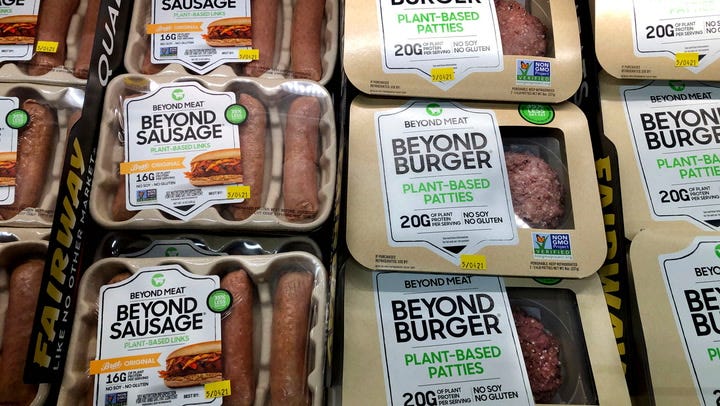Beyond Meat’s Chapter 11 Bankruptcy Filing: A Tale of Financial Woes and Consumer Backlash
On August 10, 2025, reports surfaced that Beyond Meat, the plant-based meat substitute giant, is preparing to file for Chapter 11 bankruptcy protection, signaling a dramatic fall for a company once hailed as a pioneer in the alternative protein market.
This development underscores a combination of financial struggles, shifting consumer preferences, and growing skepticism about the health implications of its highly processed products.
Understanding Bankruptcy: Chapter 11 and Beyond
Bankruptcy is a legal process that allows individuals or businesses overwhelmed by debt to reorganize or liquidate their assets under court supervision. In the United States, the Bankruptcy Code outlines several types, each serving distinct purposes:
-Chapter 7 (Liquidation): This involves selling off a debtor’s non-exempt assets to pay creditors. It’s typically used by individuals or businesses with no viable path to recovery, leading to the dissolution of the company.
-Chapter 11 (Reorganization): Often called “reorganization bankruptcy,” Chapter 11 allows a business to continue operating while restructuring its debts. The company proposes a plan to repay creditors over time, often by renegotiating terms or securing new financing. This is the path Beyond Meat is reportedly taking.
-Chapter 13 (Wage Earner’s Plan): Designed for individuals with regular income, it allows them to create a repayment plan to settle debts over three to five years.
-Chapter 12: Tailored for family farmers and fishermen, offering debt restructuring similar to Chapter 13.
-Chapter 9: For municipalities, like cities or counties, to reorganize debts.
-Chapter 15: Addresses cross-border insolvency cases involving international debts.
Chapter 11 is Beyond Meat’s chosen route because it allows the company to keep operating while attempting to address its financial challenges. This filing provides a breathing room to negotiate with creditors, restructure over $1.2 billion in debt (mostly from convertible bonds issued in 2021, maturing in 2027), and attempt a turnaround amid dwindling cash reserves of just $117 million as of mid-2025.
Why Is Beyond Meat Filing for Chapter 11?
Beyond Meat’s descent into Chapter 11 stems from a perfect storm of financial and market challenges:
1. Plummeting Sales: The company reported a second-quarter revenue of $75 million in 2025, a 20% drop year-over-year, missing Wall Street’s $82 million estimate. Refrigerated plant-based meat sales in the U.S. fell 17.2%, and frozen alternatives dropped 8.1%, reflecting a broader slowdown in the plant-based meat market.
2. Mounting Debt: With $1.2 billion in debt and only $117 million in cash, Beyond Meat faces a liquidity crisis. Its stock price, once near $235 after its 2019 IPO, has collapsed to less than 3% of its peak, making it impossible to convert its bonds and forcing repayment in cash it doesn’t have.
3. Fierce Competition: The plant-based meat market has become crowded with competitors, from established food giants to private labels, eroding Beyond Meat’s pricing power and market share. The company’s lack of strong intellectual property has allowed rivals to flood the market with cheaper alternatives.
4. Shifting Consumer Preferences: Consumers are increasingly turning away from highly processed plant-based products, favoring whole-food options like lentils, tofu, or real meat. Growing skepticism about processed foods, coupled with scrutiny from nutritionists, has hurt Beyond Meat’s appeal.
5. Failed Partnerships and Cost-Cutting: High-profile fast-food partnerships with McDonald’s, Starbucks, and Taco Bell fizzled out, with products like the McPlant failing to gain traction. Beyond Meat has also laid off 6% of its North American workforce (44 employees) and suspended operations in China to cut costs, but these measures haven’t stemmed the tide.
Health Concerns: Is Beyond Meat’s “Fake Meat” Harmful?
Beyond Meat’s products, like the Beyond Burger and Beyond Beef, are engineered to mimic the taste, texture, and cooking experience of animal-based meat using plant-derived proteins, fats, and a litany of additives. Critics argue that these highly processed ingredients raise significant health concerns, particularly when compared to real, organic, grass-fed meat.
-Complex Ingredient Lists: Beyond Meat products contain ingredients like pea protein isolate, canola oil, methylcellulose, and various flavorings and stabilizers. These are far removed from whole foods and undergo extensive processing, which some studies suggest may contribute to inflammation or digestive issues. For example, highly processed oils like canola can be high in omega-6 fatty acids, potentially promoting inflammation when consumed in excess.
-Potential Carcinogenic Risks: While no definitive evidence labels Beyond Meat’s ingredients as carcinogenic, critics point to the heavy processing and additives like artificial flavorings or preservatives, which have raised concerns in broader studies on ultra-processed foods. The long-term health impacts of these ingredients remain under-researched, fueling skepticism.
-Nutritional Shortfalls: Beyond Meat’s marketing has faced scrutiny, with a 2025 class-action lawsuit alleging the company misrepresented the protein content and quality in products like Beyond Sausage and Beyond Beef. The settlement, offering $7.5 million to consumers who purchased products between 2018 and 2024, highlights doubts about the nutritional value of these substitutes.
In contrast, organic, grass-fed meat is often championed for its simplicity and nutritional benefits. Grass-fed beef is rich in omega-3 fatty acids, conjugated linoleic acid (CLA), and vitamins like B12 and iron, with fewer additives than processed plant-based alternatives. Critics argue that Beyond Meat’s products, marketed as healthier and eco-friendly, are a far cry from the nutrient-dense profile of minimally processed, pasture-raised meats. The backlash against “fake meat” reflects a broader consumer shift toward whole, unprocessed foods, further undermining Beyond Meat’s market position.
The Bigger Picture: A Market Misstep?
Beyond Meat’s Chapter 11 filing is a cautionary tale of overhyping a trend without addressing fundamental consumer concerns. The company rode the wave of veganism and environmental consciousness but failed to anticipate the backlash against ultra-processed foods and the enduring appeal of real meat. As Rachel Wolff, an analyst at Emarketer, noted, many consumers are opting for cheaper, protein-rich animal products over expensive plant-based substitutes.
Efforts to pivot—such as dropping “Meat” from its branding and introducing reformulated products—have yielded modest results. The company’s financial straits, compounded by a class-action lawsuit over misleading protein claims and failed fast-food ventures, paint a grim picture.




